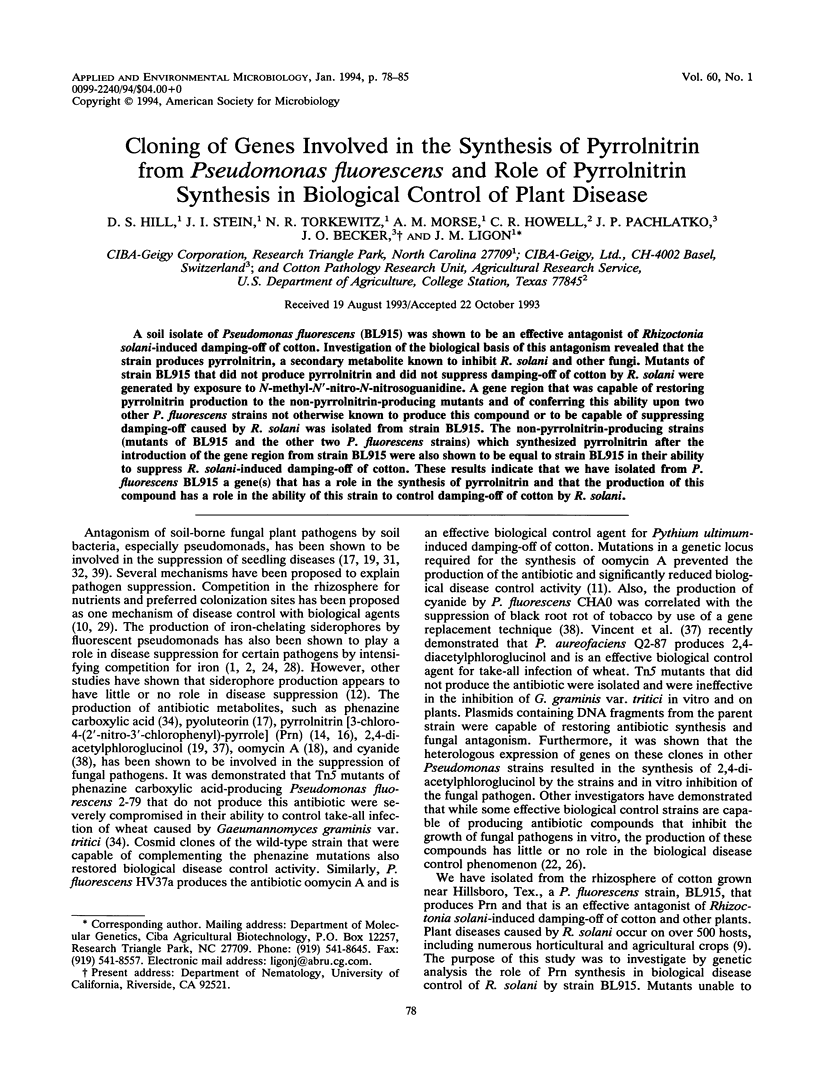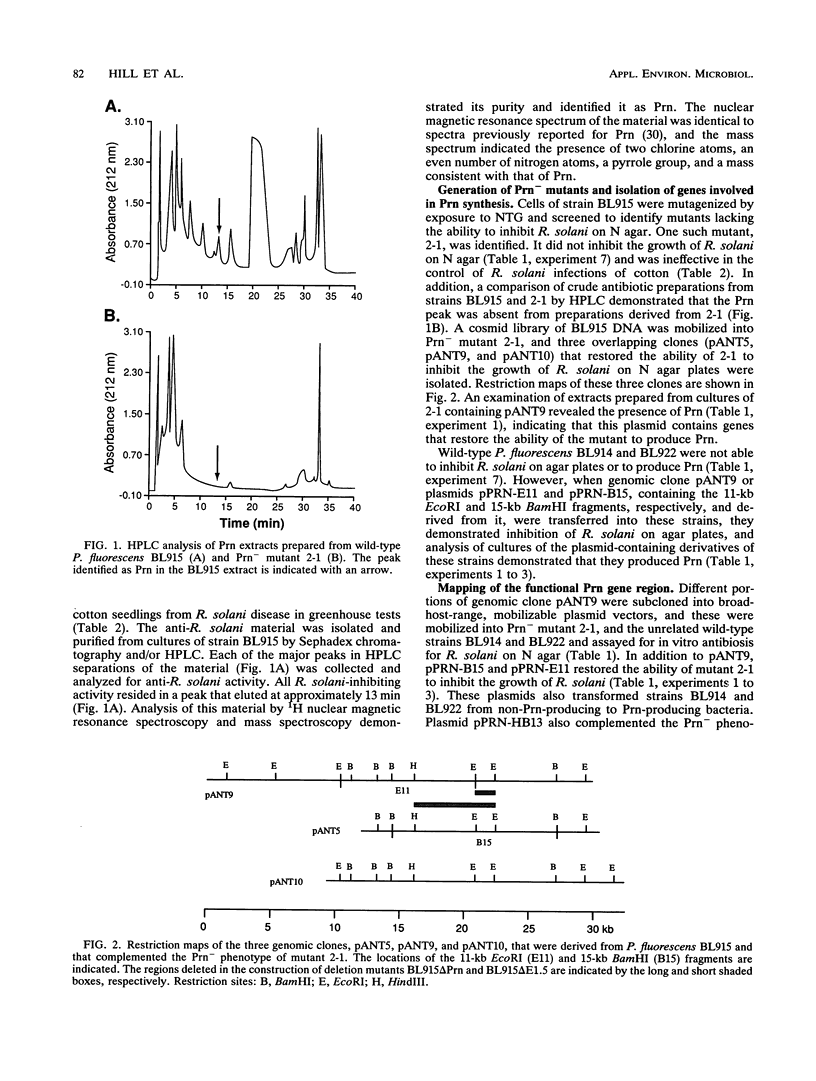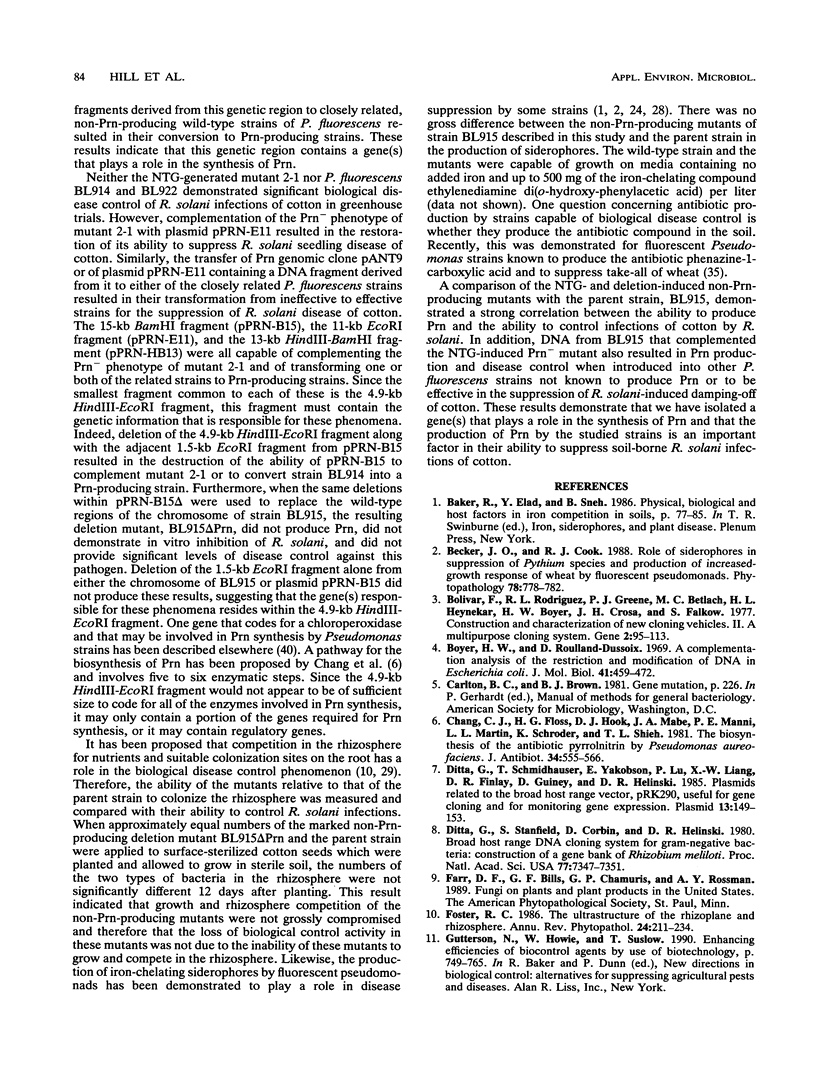Abstract
A soil isolate of Pseudomonas fluorescens (BL915) was shown to be an effective antagonist of Rhizoctonia solani-induced damping-off of cotton. Investigation of the biological basis of this antagonism revealed that the strain produces pyrrolnitrin, a secondary metabolite known to inhibit R. solani and other fungi. Mutants of strain BL915 that did not produce pyrrolnitrin and did not suppress damping-off of cotton by R. solani were generated by exposure to N-methyl-N′ -nitro-N-nitrosoguanidine. A gene region that was capable of restoring pyrrolnitrin production to the non-pyrrolnitrin-producing mutants and of conferring this ability upon two other P. fluorescens strains not otherwise known to produce this compound or to be capable of suppressing damping-off caused by R. solani was isolated from strain BL915. The non-pyrrolnitrin-producing strains (mutants of BL915 and the other two P. fluorescens strains) which synthesized pyrrolnitrin after the introduction of the gene region from strain BL915 were also shown to be equal to strain BL915 in their ability to suppress R. solani-induced damping-off of cotton. These results indicate that we have isolated from P. fluorescens BL915 a gene(s) that has a role in the synthesis of pyrrolnitrin and that the production of this compound has a role in the ability of this strain to control damping-off of cotton by R. solani.
Full text
PDF







Selected References
These references are in PubMed. This may not be the complete list of references from this article.
- Bolivar F., Rodriguez R. L., Greene P. J., Betlach M. C., Heyneker H. L., Boyer H. W., Crosa J. H., Falkow S. Construction and characterization of new cloning vehicles. II. A multipurpose cloning system. Gene. 1977;2(2):95–113. [PubMed] [Google Scholar]
- Boyer H. W., Roulland-Dussoix D. A complementation analysis of the restriction and modification of DNA in Escherichia coli. J Mol Biol. 1969 May 14;41(3):459–472. doi: 10.1016/0022-2836(69)90288-5. [DOI] [PubMed] [Google Scholar]
- Chang C. J., Floss H. G., Hook D. J., Mabe J. A., Manni P. E., Martin L. L., Schröder K., Shieh T. L. The biosynthesis of the antibiotic pyrrolnitrin by Pseudomonas aureofaciens. J Antibiot (Tokyo) 1981 May;34(5):555–566. doi: 10.7164/antibiotics.34.555. [DOI] [PubMed] [Google Scholar]
- Ditta G., Schmidhauser T., Yakobson E., Lu P., Liang X. W., Finlay D. R., Guiney D., Helinski D. R. Plasmids related to the broad host range vector, pRK290, useful for gene cloning and for monitoring gene expression. Plasmid. 1985 Mar;13(2):149–153. doi: 10.1016/0147-619x(85)90068-x. [DOI] [PubMed] [Google Scholar]
- Ditta G., Stanfield S., Corbin D., Helinski D. R. Broad host range DNA cloning system for gram-negative bacteria: construction of a gene bank of Rhizobium meliloti. Proc Natl Acad Sci U S A. 1980 Dec;77(12):7347–7351. doi: 10.1073/pnas.77.12.7347. [DOI] [PMC free article] [PubMed] [Google Scholar]
- Hamdan H., Weller D. M., Thomashow L. S. Relative importance of fluorescent siderophores and other factors in biological control of Gaeumannomyces graminis var. tritici by Pseudomonas fluorescens 2-79 and M4-80R. Appl Environ Microbiol. 1991 Nov;57(11):3270–3277. doi: 10.1128/aem.57.11.3270-3277.1991. [DOI] [PMC free article] [PubMed] [Google Scholar]
- KING E. O., WARD M. K., RANEY D. E. Two simple media for the demonstration of pyocyanin and fluorescin. J Lab Clin Med. 1954 Aug;44(2):301–307. [PubMed] [Google Scholar]
- Knauf V. C., Nester E. W. Wide host range cloning vectors: a cosmid clone bank of an Agrobacterium Ti plasmid. Plasmid. 1982 Jul;8(1):45–54. doi: 10.1016/0147-619x(82)90040-3. [DOI] [PubMed] [Google Scholar]
- McLoughlin T. J., Quinn J. P., Bettermann A., Bookland R. Pseudomonas cepacia suppression of sunflower wilt fungus and role of antifungal compounds in controlling the disease. Appl Environ Microbiol. 1992 May;58(5):1760–1763. doi: 10.1128/aem.58.5.1760-1763.1992. [DOI] [PMC free article] [PubMed] [Google Scholar]
- Schroth M. N., Hancock J. G. Disease-suppressive soil and root-colonizing bacteria. Science. 1982 Jun 25;216(4553):1376–1381. doi: 10.1126/science.216.4553.1376. [DOI] [PubMed] [Google Scholar]
- Staskawicz B., Dahlbeck D., Keen N., Napoli C. Molecular characterization of cloned avirulence genes from race 0 and race 1 of Pseudomonas syringae pv. glycinea. J Bacteriol. 1987 Dec;169(12):5789–5794. doi: 10.1128/jb.169.12.5789-5794.1987. [DOI] [PMC free article] [PubMed] [Google Scholar]
- Thomashow L. S., Weller D. M., Bonsall R. F., Pierson L. S. Production of the antibiotic phenazine-1-carboxylic Acid by fluorescent pseudomonas species in the rhizosphere of wheat. Appl Environ Microbiol. 1990 Apr;56(4):908–912. doi: 10.1128/aem.56.4.908-912.1990. [DOI] [PMC free article] [PubMed] [Google Scholar]
- Thomashow L. S., Weller D. M. Role of a phenazine antibiotic from Pseudomonas fluorescens in biological control of Gaeumannomyces graminis var. tritici. J Bacteriol. 1988 Aug;170(8):3499–3508. doi: 10.1128/jb.170.8.3499-3508.1988. [DOI] [PMC free article] [PubMed] [Google Scholar]
- Vieira J., Messing J. The pUC plasmids, an M13mp7-derived system for insertion mutagenesis and sequencing with synthetic universal primers. Gene. 1982 Oct;19(3):259–268. doi: 10.1016/0378-1119(82)90015-4. [DOI] [PubMed] [Google Scholar]
- Vincent M. N., Harrison L. A., Brackin J. M., Kovacevich P. A., Mukerji P., Weller D. M., Pierson E. A. Genetic analysis of the antifungal activity of a soilborne Pseudomonas aureofaciens strain. Appl Environ Microbiol. 1991 Oct;57(10):2928–2934. doi: 10.1128/aem.57.10.2928-2934.1991. [DOI] [PMC free article] [PubMed] [Google Scholar]
- Voisard C., Keel C., Haas D., Dèfago G. Cyanide production by Pseudomonas fluorescens helps suppress black root rot of tobacco under gnotobiotic conditions. EMBO J. 1989 Feb;8(2):351–358. doi: 10.1002/j.1460-2075.1989.tb03384.x. [DOI] [PMC free article] [PubMed] [Google Scholar]
- Wolfframm C., van Pée K. H., Lingens F. Cloning and high-level expression of a chloroperoxidase gene from Pseudomonas pyrrocinia in Escherichia coli. FEBS Lett. 1988 Oct 10;238(2):325–328. doi: 10.1016/0014-5793(88)80505-2. [DOI] [PubMed] [Google Scholar]


